Intonation, you’ve heard the term but you may not understand its meaning. When the word arises, think “in tone” or “in tune”. This article will explain both proper and improper intonation and steps that can be taken to correct the latter.
Intonation On a Stringed Instrument
Intonation is a fretted instrument’s ability to play the correct note at every fretted position on the neck. As an example, a guitar’s low-E string is tuned exactly at the E note, and fretting the string a another location, say the 3rd fret, you should be playing an exact G note, the fifth fret should be an exact “ A” and the seventh fret a “B” and so on all the way up the neck. This concept holds for every string on the instrument.
Getting it Right
In order to achieve correct intonation, a fingerboard is designed (and built) with the frets placed in a precise location for a specific length of guitar string. The string length is defined as the distance between the edge of the nut closest to the fingerboard to where the string contacts the saddle. To account for the differing string thicknesses, the saddle on an acoustic guitar is slanted such the high E-String is closest to the nut with subsequent heavier gauge (thicker) strings are progressively further from the nut (see figure 5 below).
Causes of Poor Intonation
There are two areas in which can cause improper intonation; 1.) the vibration length of the string between the nut and the saddle is incorrect OR 2.) the frets are incorrectly position in the fingerboard. The first is correctible while the latter is not – unless the fingerboard is replaced. However, frets being installed out of position is rare and something I’ve never experienced. As such, that variable can be dropped from this discussion. So let’s concentrate on string length.
We’ll simplify the discussion by focusing on only one fret – the 12th. This is the octave fret for the fingerboard and should be exactly in the middle of the string when the string is pressed (fig.1). When plucked, it should be a perfect octave of the open string (unfretted) note.
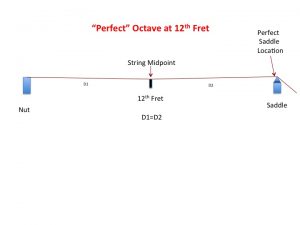
If the string is too long (fig. 2), or two short (fig. 3), the twelfth fret is no longer sitting at the midpoint of the strings and the octave note will be respectively flat or sharp.
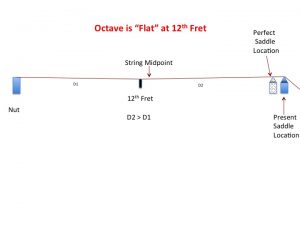
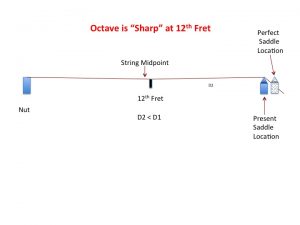
In all these illustrations, it’s important to remember that the twelfth fret is stationary and the mid-point of the string is moving is shifted in each figure because of the change of string length.
Correcting Improper Intonation
Correcting a string’s vibration length discrepancy may be as simple as reducing the height of the string over the fret’s when fretted (pushed-down) A string sitting high over the fingerboard is stretched enough to change it’s vibrating length resulting in an intonation issue. A proper set-up (see the previous blog) could be all that is needed to correct the discrepancy.
Most likely the culprit is the string’s contact point of the saddle is in the wrong position and moving contact edge of the saddle forward (towards the neck) or back (towards the guitars end) will correct the string length discrepancy. This is straightforward on most electric guitars as each string has it’s own separate saddle with an adjustment screw (Fig. 4). Depending on which direction the screw is turned, the saddle will move forward (shortening the vibration length) or back (lengthening the vibration length).
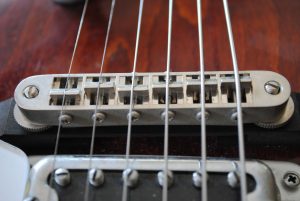
Acoustic guitars do not have this option as all six strings share a single saddle (Fig. 5) and the saddle has to be carefully filed to put the string in the proper contact location on the top of the saddle. This is best left to a professional.
So, there you have it. You are now an intonation expert. Happy Playing!
– Steve
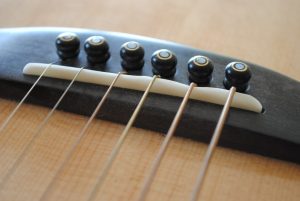
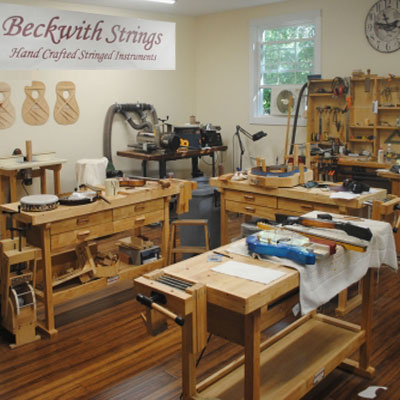 Steve Beckwith has handcrafted over one hundred acoustic stringed instruments to address the need of musicians unable to find the exact sound from mass manufacturing instruments.
Steve Beckwith has handcrafted over one hundred acoustic stringed instruments to address the need of musicians unable to find the exact sound from mass manufacturing instruments.
Great explanation of intonation. Now i get it.
Thanks Gene! I’m glad you “got it” just by reading the text. I have a new website and when the blogs were imported to it, the images were lost. I just uploaded the images to the blog this morning so you may want to take another look.
– Steve
Hi Cody, Do you have trouble keepnig it in tune even when it is in standard tuning? The Drop tunings result in looser strings, which may be a contributing factor. Also, the gauge of your strings may possibly be a factor. If it continues to be a problem, I’d suggest having it checked out by a pro. It’s awful to want to play, and yet be working with an instrument that won’t quite behave!
I read lots of info on other sites, but this site explains it best. now I understand. Thanks
Thanks Steve! That’s quite a compliment!
– Steve
Great explanation, Steve!
Thanks Rick!